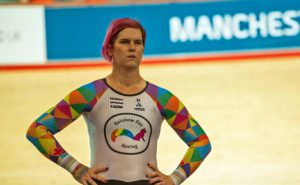In the world of sport, there are few things more exciting than an underdog story. The scrappy boxer who punches above his weight; the last-minute victory; the team of ragtag misfits who win the day through sheer grit and determination. Underdogs make for good stories for the same reason they make for a good game: it feels like poetry when they win.
For a long time, the runner Caster Semenya made for a terrific and compelling true-life underdog. In a world that was increasingly cognisant of the oppressive interplay of race, gender and class, here was a woman, black and gender non-conforming — a 2009 New Yorker article described her as “breathtakingly butch” — battling against a racist, sexist system that wanted to keep her down. Her trajectory from an impoverished running club in rural South Africa to the winner’s podium at the Olympics was Hollywood movie material, and the repeated indignities she suffered at the hands of officials and fellow competitors who questioned her right to be there were an outrage: Semenya was dogged by rumours that she was a man in disguise, and was routinely required to prove her sex by submitting to humiliating inspections of her genitals. It all seemed like the work of a snivelling patriarchy conspiring to take down an exceptional woman.
But the truth was more complicated: Semenya is a woman — by her own definition, and in virtually every social context that matters — but she is also not exactly female. Testing eventually revealed her to be intersex, possessing an XY chromosomal makeup and a pair of internal, undescended testes, which among other advantages meant she could produce performance-enhancing testosterone at levels that an ordinary female could not.
Athletic governing bodies struggled to come up with a policy that would allow someone like Semenya to continue competing: when she declined to remove her internal testes, they required her to take drugs to suppress her testosterone production. The solution satisfied no one, including Semenya, who found hormone therapy intolerable. In an essay adapted from her new memoir, The Race to Be Myself, she writes: “If I had internal testicles or whatever they were saying I had, they were mine. I was healthy, I loved my body, and it had made me a champion. Why must I go and mutilate it to conform to someone else’s rules?”
In one sense, it is only fair that someone who moves through the world as a woman be allowed to compete alongside women. “I didn’t care then, and I don’t care now what the medical findings are,” Semenya writes. “I was born a girl and raised as a girl.” But socialisation is only one piece of the puzzle when it comes to defining womanhood in sports; science matters, too. And the concept of protected classes in sport also stems from a desire to be fair. Women, disabled people, the very old or very young: all of them compete on playing fields that only admit people who share certain characteristics, which is to say, certain limitations. The boundaries around these fields have always been human-drawn and hence imperfect, but they are also necessary; the alternative, as the International Paralympic Committee notes, is “one-sided and predictable competition, in which the least impaired athlete always wins”.
Semenya, in her book, puts scare quotes around the words “protected class” as if to mock the idea that it could apply to women, but the argument doesn’t land — not least because her presence in women’s sports has more often than not given rise to exactly the sort of one-sided, predictable outcome the IPC works to avoid. Semenya mops the floor with her competitors, and the women who have raced against her have noted that it doesn’t feel like a fair fight. And while nobody likes to think that half the planet can be reasonably classified as impaired compared with the other half — that womanhood itself is something akin to disability — the truth is: the acceptance that women are weaker is the essential foundation of women’s sports. Men jump higher, run faster, kick and punch harder. And if women’s sport is a ghetto of sorts, it is a necessary one, not just for fairness or safety’s sake but for the sake of sport. Nobody wants a one-sided and predictable competition; we want drama and excitement. This is why we play sport, and why we watch other people doing it. We love to see them fight; we love a win against the odds.
There’s something viscerally distasteful about the inverse: somebody with too much strength clobbering someone who has too little. An able-bodied athlete dunking on a guy in a wheelchair; a grown man winning a sprint against a bunch of 8-year-olds. A ringer parachuted into an amateur competition. We watch in pursuit of the kind of fairness that makes for a good game.
This doesn’t mean that the line where an attribute becomes an unfair advantage is always easy to discern. Years ago, the Olympics governing body became embroiled in a debate over whether Oscar Pistorius’s bionic legs gave him an unfair advantage, leading to months of rigorous study that culminated in the following remarkable conclusion, published in The Journal of Applied Physiology: Pistorius, the scientists agreed, was “physiologically similar but mechanically dissimilar” to an athlete with normal human legs. (Pistorius was allowed to run.) But to the general public, fairness in sport is like obscenity as famously defined by Supreme Court Justice Potter Stewart: we know it when we see it.
This is what makes Semenya’s case so complicated. The notion of her being some sort of cheater is flawed. When she balked at suppressing her hormone levels, it wasn’t because she wanted to win; it was because it felt like lying: “I wasn’t going to take on an identity that did not fit my soul because some doctors had taken my blood and images of my organs. I was not a hermaphrodite or anything other than a woman.”
In her memoir, Semenya is largely describing events from over a decade ago. But the book has been published into a world where a related, ongoing battle is raging, over the place of trans women in sports. These issues are not identical, of course: Semenya never imagined she was anything other than biologically female, while trans women are seeking admission to a category they know full well they were not born into. But both have been plagued by allegations that they’re trying to game the system, that they’re cheaters. Often, trans women are presented as just a bunch of grasping, avaricious men who’ve found the easiest possible pathway to a gold medal. When ESPN aired a special about trans swimmer Lia Thomas, her former competitor Riley Gaines slammed both the network and the athlete as complicit in the destruction of women’s sports: “Lia Thomas is not a brave, courageous woman who earned a national title. He is an arrogant, cheat who stole a national title from a hardworking, deserving woman.”
This knee-jerk demonisation has always seemed wrong to me — morally, but also logically. The humiliation, the opprobrium, the physical and mental burden of transitioning: all seem like a wildly disproportionate price to pay for the sake of a college swimming championship. Instead, what has always struck me about Thomas’s case is that elite swimming is one of the few arenas where the women celebrated are broad shouldered, long limbed, and tall. Perhaps swimming represents, to her, a chance to feel not just like a winner, but like she belongs.
This is the tragedy: that what is fair at the macro level is not fair, as in compassionate, to an individual person. Lia Thomas cannot fairly compete in the sporting category known as “women”, and arguably neither can Semenya, whose memoir presents this as an obscene attempt to deny her identity. No doubt it felt that way to her: to alter her body to compete with women would have amounted, in her mind, to a tacit admission that she wasn’t one.
And as long as women’s sports are seen as having the power to validate or invalidate one’s innate sense of self — for as long as we see the regulatory bodies as not just deciding who can compete as a woman, but who is one — this issue will remain intractable. The best hope is a future where the category of “woman” in sports is treated in much the same way as the IPC treats the category of “disabled”: “If an athlete is not eligible to compete in a sport, this does not question the presence of a genuine impairment,” the committee website assures readers. “It is a sport ruling.”
The truth, unfortunate but inevitable, is this: the most carefully drawn lines, the ones that need to not just include but protect, will always leave someone on the outside.
Disclaimer
Some of the posts we share are controversial and we do not necessarily agree with them in the whole extend. Sometimes we agree with the content or part of it but we do not agree with the narration or language. Nevertheless we find them somehow interesting, valuable and/or informative or we share them, because we strongly believe in freedom of speech, free press and journalism. We strongly encourage you to have a critical approach to all the content, do your own research and analysis to build your own opinion.
We would be glad to have your feedback.
Source: UnHerd Read the original article here: https://unherd.com/



